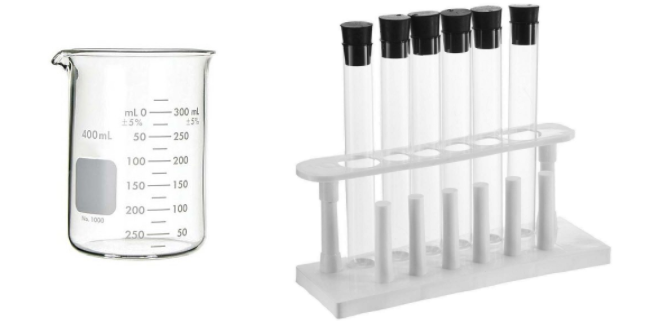Lab Equipment Explained
Laboratory equipment is extremely important to all scientists. They need to know how to use it, store it, and most importantly name it. If you want to be a scientist, you need to know some basic equipment that is needed for research and experiments, which you will learn right now!
First of all, safety goggles, closed shoes, and a coat (or a shirt with sleeves and long pants).
Safety is the priority when you are in the lab, so you must wear everything, especially goggles, at all times until you leave the lab!
Next, the fun stuff starts. From left to right: Erlenmeyer flask is perfect for stirring and mixing because nothing will spill from it! It is also often used for titration (method of determining concentration of a dissolved substance in a solution). Boiling flask, also known as a Florence flask, is usually attached to a ring stand due to its round bottom. It is usually used for distillation (process of purifying a liquid by heating it to vapor and then cooling it to a liquid again).
From left to right: beakers are used for heating substances, stirring, and mixing chemicals. A little spout is made for easily pouring liquids to other flasks. Test tubes are very common in labs. They are usually used for holding small pieces of a chemical for it to be tested. The container that test tubes are usually stored (what you see in the picture) is called a tube rack!
From left to right: graduated cylinders are used for measuring liquids. They come in many different volumes from 10 mL to 1000 mL. Volumetric flask measures a specific volume, depending on what volume this flask is. You can easily mix solutions in them, and also invert them several times to mix solutions.
From left to right: funnels can be made either from plastic or from glass (these are the most common ones). It can have short and long stems, depending on what is needed in an experiment. They also can come in different sizes. Watch glass is slightly concave, which can hold a small amount of solids or liquids. They sometimes can be used as a lid for a beaker. Just like funnels, they also come in different sizes. Ring stands are used to hold beakers and/or flasks that cannot stand on their own.
Top picture: Pasteur pipette is used to hold very small volumes. From left to right: Volumetric pipette is used for measuring a volume of a liquid and is extremely accurate. Graduated pipette measured the volume of a liquid according to its markings.
From left to right: Clamps are used for holding flasks or beakers on a ring stand. Crucible tongs or just tongs are used for moving hot things, clenching them in between.
From left to right: Bunsen burner is used to heat things, it is usually used with a flask attached to a ring stand. Petri dishes can be made either from plastic, rubber, or glass and are used to grow samples (for example, mold or bacteria).
Of course, there are other things that laboratories have, but these are the most common ones!








